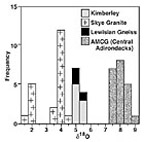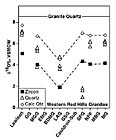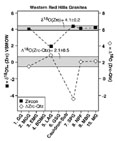Low d18O Magma, Isle of Skye, Scotland: Evidence from Zircons
Gilliam, Carrie E. and Valley, John W., (1997) Low d18O magma, Isle of Skye, Scotland: Evidence from zircons. Geochimica et Cosmochimica Acta, v. 61, n. 23, p. 4975-4981
Abstract
Zircons in Tertiary granitic rocks from the Isle of Skye, Scotland were resistant to measurable oxygen isotope exchange during intense hydrothermal activity in the subvolcanic environment. Five granite bodies from the Western Red Hills complex were investigated; four have 18O(Zrc) = 4.1 ± 0.2‰ (VSMOW) while the fifth, which intruded before major cauldron subsidence, is 2‰ lower. Zircons from Lewisian gneiss are visually and isotopically distinct indicating that zircons in the granite are not xenocrysts from the Lewisian basement. Analysis of different magnetic and size fractions of zircon shows no significant correlation to d18O supporting the conclusion that these values represent the true magmatic compositions and that the Western Red Hills granites intruded as low d18O magmas with a whole rock d18O£ 6.0‰. Quartz separates from four granites are close to the calculated magmatic values in d18O, but in the fifth, values are 5‰ lower indicating variable exchange of quartz with low d18O heated meteoric waters. These results might be explained by magmatic interaction with hydrothermally altered crust early in the evolution of the granites, before crystallization of zircon, followed by interaction with later hydrothermal fluids. Alternatively, independent evidence for low d18O mafic magmatism in NW Scotland suggests the presence of large quantities of low d18O subducted ocean crust in the subcontinental lithosphere that could contaminate or be the source of low d18O mantle-derived melts.


